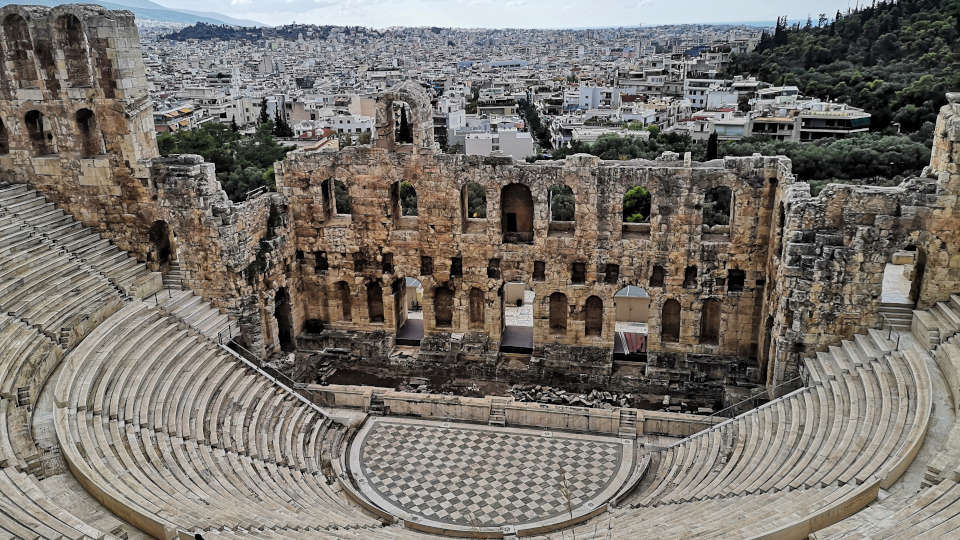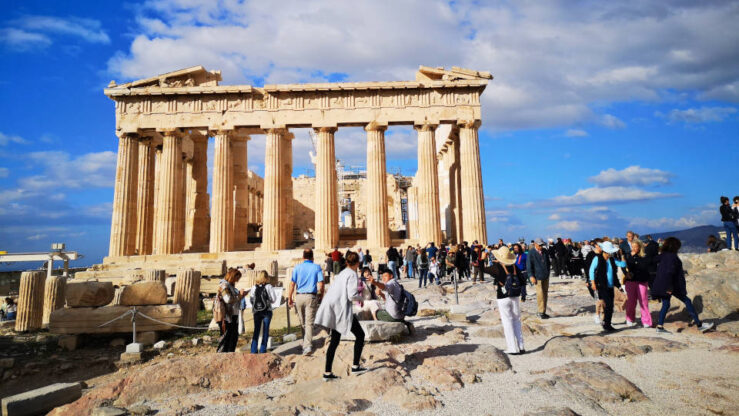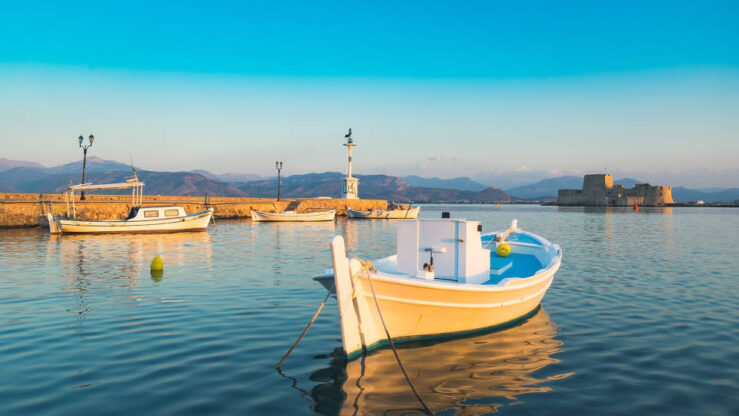Where to stay in Athens (before or after your cruise) Plaka, Piraeus…?
1. Plaka
2. Monastiraki
3. Makryanni
4. Psyri
5. Exarcheia
6. Syntagma
7. Piraeus
To help you decide where to stay in Athens, you will find a description of some of the best and most popular neighbourhoods in the city below – Your choice will depend on whether you want to stay near the Acropolis, Plaka and other ancient attractions, want to feel the local vibe, stay in a tranquil and less touristy area, seek an alternative neighbourhood, are on a tight budget, or want to stay in a place that is convenient for a cruise out of Piraeus.
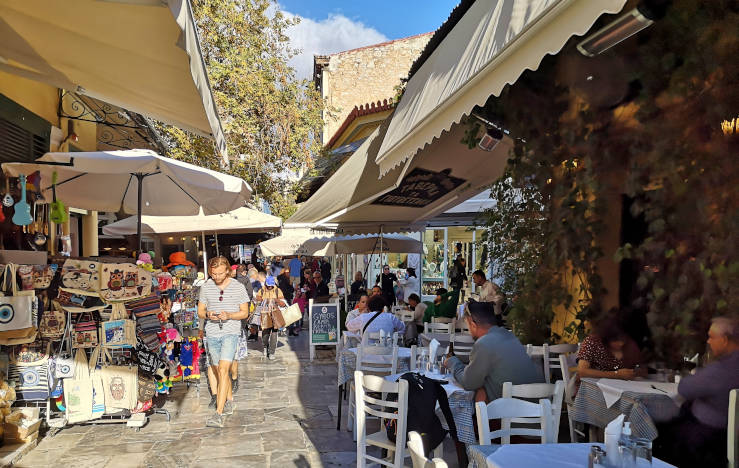
Plaka Athens | Photo: Travel In Culture
If you love to stay in a vibrant neighbourhood with local ambience, Greek tavernas, plenty of souvenir shops, musicians performing, and narrow alleys with stairs leading to secret places behind the touristy main street, then Plaka at the foot of the Acropolis is an excellent choice in Athens. You can find real gems hidden away in the side streets, and it can even be exciting to get a little lost in this part of the city.
You will stay in Plaka if you want to feel the local vibe from the moment you step out of the hotel door in the morning. There are plenty of dining options just around the corner – and you will have the Acropolis within easy reach!
Plaka is one of the places that are must-sees in Athens. The Neighbourhood of the Gods attracts tourists and locals alike to its maze of neoclassical architecture, antique shops, local churches, and curious people visiting one of the oldest areas of Athens today. The neighbourhood is quite village-like with old cobblestone streets, orange and lime trees, and small quaint shops selling everything from clothes, bags and ceramics to souvenirs, jewellery, and local specialities.
There are many interesting buildings in Plaka – in many different architectural styles. These include eye-catching colourful houses, whitewashed, yellow and orange walls lined with purple bougainvillaea, and local churches that you can enter to catch a glimpse of the Greek Orthodox culture. Plaka is a gem of a neighbourhood in Athens where you can easily spend hours exploring the intricate alleys and discovering awesome small family-run tavernas.
In Plaka, you are also close to ancient times in Athens, with the Acropolis soaring above the streets and the Arch of Hadrian right on the edge of the district. The Acropolis and the new Acropolis Museum are within reasonable walking distance to visit once you have settled in and are ready for the ancient sights.
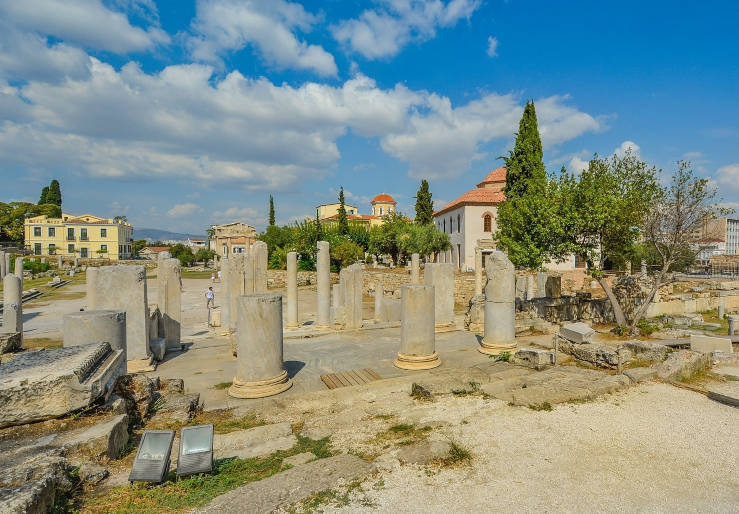
The Roman Agora | Photo: user32212 / Pixabay
One of the popular neighbourhoods in Athens is Monastiraki, located north of the Acropolis. It is a local neighbourhood with a flea market, street artists, souvenir vendors, vintage shops, and some of the most famous archaeological sites. The central location makes it popular among first-time visitors to Athens.
You may choose Monastiraki if you feel tempted to stay in a historic one of the oldest districts in Athens, inhabited for thousands of years. The ancient sights include Hadrian’s Library, the Ancient Agora of Athens, and the Roman Agora. At the same time, it is an area in Athens with a great local vibe!
An eye-catching building in Monastiraki is the Tzistarakis Mosque, just off vibrant Monastiraki Square, erected in 1759 in the Ottoman period. Over the years, it has served many purposes, including military barracks, a prison, and a warehouse. Close to the mosque, you will find the remnants of Hadrian’s Library, constructed in 132 AD by the Roman emperor Hadrian.
Just a stone’s throw away, you will spot the Roman Agora. It was erected by order of the emperor Augustus and used to be Athens’ central market and gathering point, with constructions such as the Tower of the Winds, a marble colonnade – and perhaps more outstanding buildings to be excavated in the future. The Roman Agora replaced the former marketplace, the Ancient Agora of Athens, which was the public meeting point for artisans, merchants, philosophers, and politicians such as Socrates and Aristotle. The Ancient Agora with the Temple of Hephaestus and the Stoa of Attalos is today known as the birthplace of democracy in Greece! The Gate of Athena Archegetis connected the two markets.
Other sights of interest include the attractive Monastiraki Flea Market, where you will find Greek delicacies, olive wood cutlery, clothes at bargain prices, and all kinds of colourful accessories.
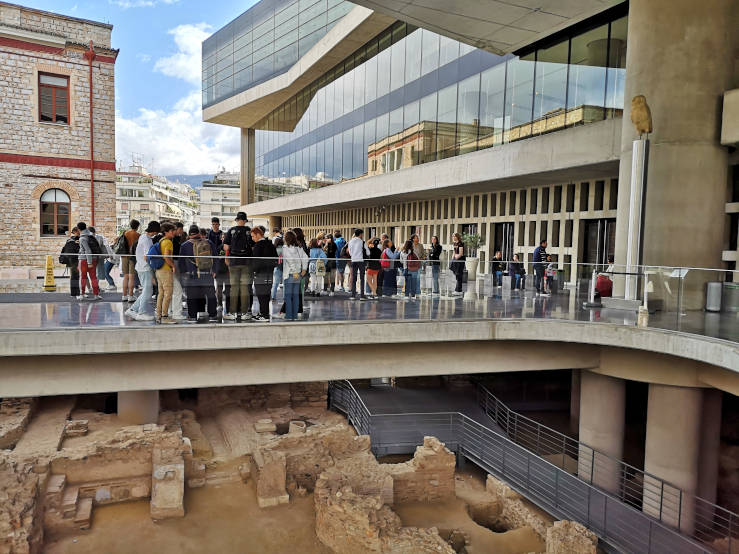
The Acropolis Museum | Photo: Travel In Culture
Makryanni is centrally located in Athens, southeast of the Acropolis. It is an upscale neighbourhood featuring the Acropolis Museum, neoclassical house façades, stores, and galleries.
If you want to stay in a part of Athens where you will have both local streets with tavernas and a wide range of shops within reach, as well as be close to the main attraction of Athens, the Acropolis, then Makryanni may be a great choice. The relatively new Acropolis Museum lies at the foot of the slope, just off the wide walking street Dionysiou Areopagitou, the perfect avenue for an evening stroll!
The highlight of Makryanni is the relatively new Acropolis Museum, an outstanding museum featuring parts of the Acropolis, such as a fine reconstruction of the Parthenon Frieze and five of the six Caryatid statues from Akropolis’s Erechtheion. The Caryatids on the Acropolis are replicas!
Of course, you have the Acropolis within easy reach – a must-see during your stay. It rises high above the city of Athens, justifying its name, which means ‘High City’. When entering through the Propylaea, you get access to the Parthenon, the Temple of Athena Nike, and the Erechtheion as some of the most famous constructions of the Acropolis.
Take a stroll along Dionysiou Areopagitou together with locals and other visitors. Just on the edge of Makryanni, you will find the Holy Church of Saint Sophia, a small fine church you can enter before continuing up to the Acropolis.
Just north of Monastiraki, you will find the neighbourhood of Psyri. That is a more budget-friendly district than Monastiraki or Plaka, and you will still be close to Athens’ ancient sights, such as the Roman Agora and the Ancient Agora of Athens, as well as Plaka’s charming streets. So, if you travel on a budget, this may be the neighbourhood to consider.
Psyri was, for many years, a run-down working-class neighbourhood, but since the late 20th century, it has developed into a trendy area that has been renovated or where new constructions have replaced many of the old. It is also an artistic neighbourhood, continuing the artisan tradition that has always been part of the place. You will discover treasures in the form of spectacular street art – sometimes political – and lovely art galleries.
When you get hungry, plenty of eateries here serve Greek specialities. Food lovers will find pleasant surprises tucked away in the narrow streets. It is a district of Athens to explore if you are looking for unusual gastronomy – for instance, in Evripidou Street, where you will find awesome little food shops with local delicacies, spices, herbs, and goodies for the sweet tooth.
The Psyri neighbourhood is relatively quiet during the day and very lively at night!
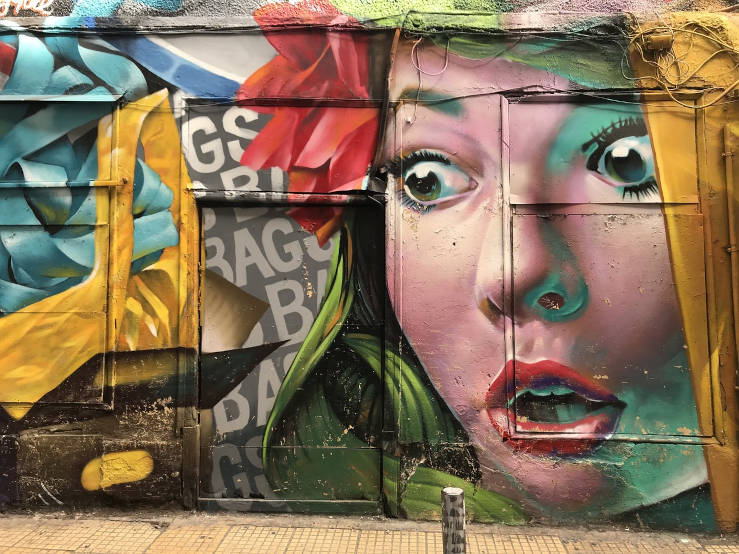
Photo: Elena / Pixabay
Northeast of the Acropolis, you will arrive at Exarcheia, Athen’s alternative neighbourhood. Here, you will find a unique vibe created by the music environment. Jazz and punk mixed with Greek blues fill the bars and clubs. Outside, you will discover murals with political messages and loads of eateries.
You will, perhaps, pick Exarcheia if it is not your first visit to Athens and you want to try to stay in an alternative and slightly anarchist part of the city where you can explore the local bookshops and vintage shops and listen to live music.
Exarcheia is for creative minds, and you will spot many unusual places and settings around the neighbourhood. The street art is complemented by art galleries, the EKPAN summer cinema, and places selling vintage items. You can take a street art tour – or chill around the green Exarcheia Square.
The district also houses the National Archaeological Museum, the most important museum in the country, with artefacts from a wealth of excavations in Greece. The collection contains around 11.000 exhibits, spanning a period from Prehistory to Late Antiquity, and is housed in a neoclassical building designed by Ernst Zeller. As a supplement to visiting the new Acropolis Museum with exhibits from the Acropolis, the National Archaeological Museum is the perfect museum to gain insight into the Ancient World.
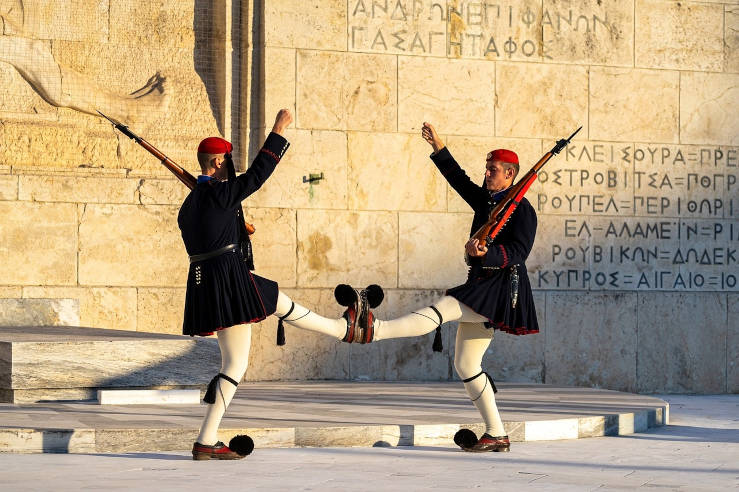
Syntagma Square – traditional soldiers guard the Tomb of the Unknown Soldier | Photo: Christo Anestev / Pixabay
Syntagma Square has a central location in Athens, and it is thus an excellent place to stay if you are a first-time visitor to the Greek capital. Here, you will be within walking distance of many of the must-see places in Athens, and it is easy to travel to other parts of the city by metro or by bus since there is a metro station (with archaeological finds on display!) and many buses conveniently stop at Syntagma Square.
The area around the square is a vibrant neighbourhood with many tavernas and dining options just around the corner, and you will have a range of stores to choose from for shopping. Moreover, it is an excellent place for people-watching! Syntagma is both the historical and modern heart of the city!
Syntagma Square, or Constitution Square, is a social, political, and cultural centre of Athens. Here, a military uprising towards the end of the 1800s resulted in the first King of Greece, Otto, providing a long-awaited constitution for Greece.
The Old Royal Palace now houses the Greek Parliament, and the Tomb of the Unknown Soldier is kept in front of it, guarded by the distinguished Presidential Guards in their traditional uniforms. You should come at 10 a.m. on Sundays to watch the most spectacular changing of the guard during the week with a parade, including a marching band. Another thing to do is take a guided tour of the Parliament.
Afterwards, chill out on a bench beneath the cypresses and citrus trees while admiring the fountain and statues.
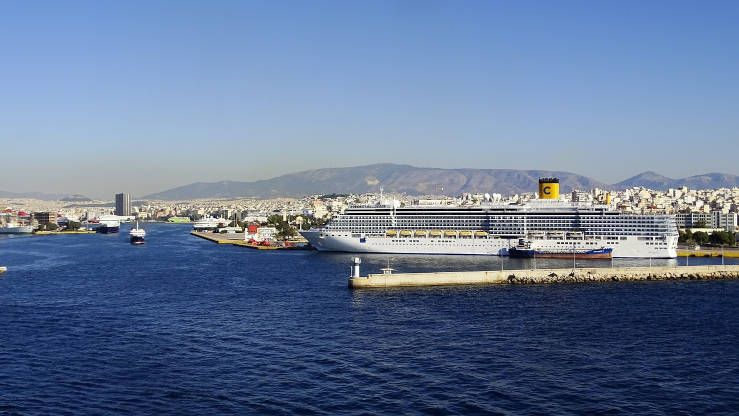
Photo: neufal54 / Pixabay
If you need to stay in Athens in connection with a cruise out of Piraeus, the obvious choice may be to stay in Piraeus one or two days before and/or after the cruise. In this way, it will be easy for you to arrive at the cruise ship for embarkation on your departure day – and, likewise, easy for you to disembark without having a long, tiring journey ahead of you on disembarkation day. You can take it easy and do things at your own pace without rushing.
Besides being a port, Piraeus is also a part of Athens with exquisite fish restaurants, fascinating museums, a flea market, and so much more to explore during a day or two here. And it is easy to go by metro to central Athens (about 15 minutes) for a full day of sightseeing there – if time permits! Piraeus has accommodation at all price levels, so it is easy to find something affordable here if you are on a budget!
Piraeus is the port of Athens, the largest Mediterranean port in terms of passenger ferries and the gateway to the Greek islands. You may also take advantage of being close to Athens’s beaches and small ferries taking you to a range of Greek islands – including islands just one or two hours away.
In Piraeus, you can visit the Hellenic Maritime Museum to gain insight into the seafarers’ exciting history. The Electrical Railway Museum, with a wooden metro carriage, is inside the metro station. Other cultural places of interest include the Archaeological Museum of Piraeus, Piraeus Municipal Art Gallery, and Piraeus Municipal Theatre.
When you’re done with the cultural stuff, there are excellent shops, tavernas, and a vibrant nightlife. And then you are ready to embark on your cruise ship: Welcome aboard.
Read next: Cool Stay at Santorini and Exploring Ancient Corinth and the Corinth Canal
Where to stay in Athens before or after your cruise – Plaka or Piraeus
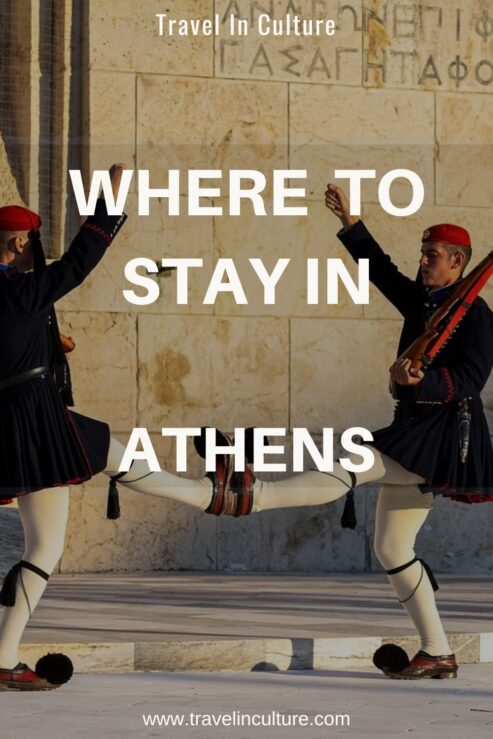
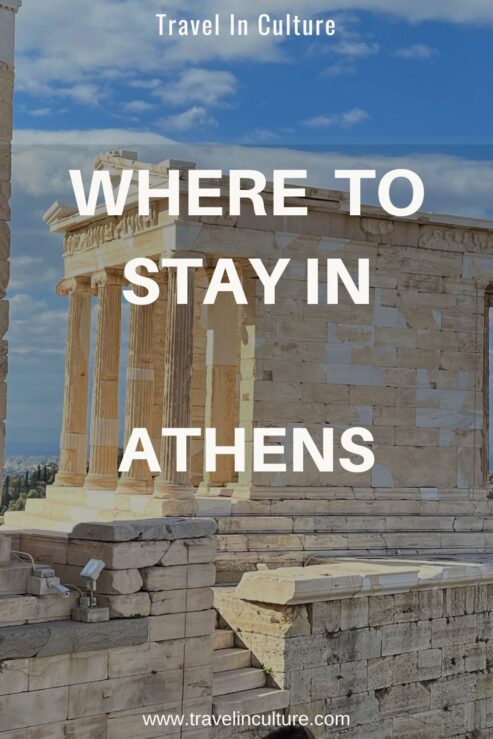
Featured image of
Where to stay in Athens before cruise – Plaka or Piraeus:
Travel In Culture
Plaka Athens – Stay Athens Plaka


